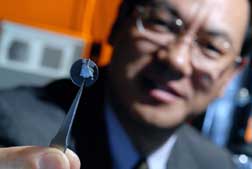Body
 |
Georgia Tech professor Zhong Lin Wang holds a sample nanowire array that can be used to power nanometer scale devices. Georgia Tech Photo: Gary Meek |
Researchers have developed a new technique for powering nanometer-scale devices without the need for bulky energy sources such as batteries.
…
Want to continue?
Log in or create a FREE account.
By logging in you agree to receive communication from Quality Digest.
Privacy Policy.
Add new comment